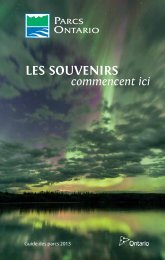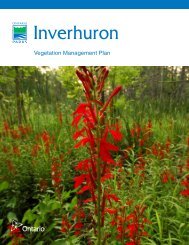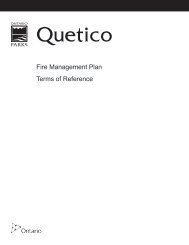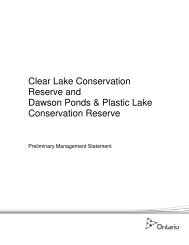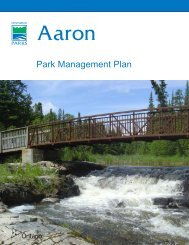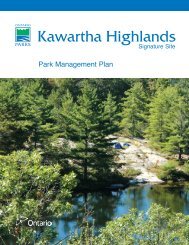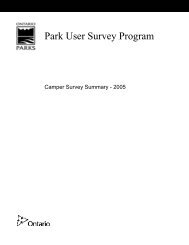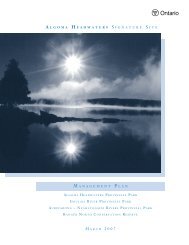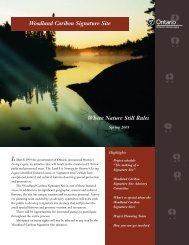Park Management Plan - Ontario Parks
Park Management Plan - Ontario Parks
Park Management Plan - Ontario Parks
Create successful ePaper yourself
Turn your PDF publications into a flip-book with our unique Google optimized e-Paper software.
O’Donnell Point<br />
<strong>Park</strong> <strong>Management</strong> <strong>Plan</strong>
MNR 52073<br />
ISBN 978-1-4249-3443-0 (Print)<br />
ISBN 978-1-4249-3444-7 (PDF)<br />
© 2007 Queen’s Printer of <strong>Ontario</strong><br />
Printed in <strong>Ontario</strong>, Canada<br />
Cover photo: <strong>Ontario</strong> <strong>Park</strong>s<br />
Additional copies of this publication can be obtained from:<br />
<strong>Park</strong> Superintendent<br />
Oastler Lake Provincial <strong>Park</strong><br />
380 Oastler <strong>Park</strong> Drive, RR #2<br />
Parry Sound, ON<br />
P2A 2W8
I am pleased to approve the O’Donnell Point <strong>Park</strong> <strong>Management</strong> <strong>Plan</strong> as the official policy for the<br />
protection and management of O’Donnell Point Provincial <strong>Park</strong>. The plan reflects the Ministry of<br />
Natural Resources’ and <strong>Ontario</strong> <strong>Park</strong>s’ intent to protect the natural features of O’Donnell Point<br />
Provincial <strong>Park</strong> and maintain and develop high quality opportunities for natural heritage<br />
appreciation for the residents of <strong>Ontario</strong> and visitors to the province.<br />
The plan contains proposed policies relating to resource stewardship, operations and development<br />
that will guide the management of O’Donnell Point Provincial <strong>Park</strong> over the next 20 years. It may<br />
be reviewed to address changing issues or conditions.<br />
The plan also includes an implementation strategy and a summary of the public consultation that<br />
occurred as part of the planning process.<br />
I wish to extend my sincere thanks to all those who participated in this important process.<br />
Yours truly,<br />
Adair Ireland-Smith<br />
Managing Director<br />
<strong>Ontario</strong> <strong>Park</strong>s<br />
i
TABLE OF CONTENTS<br />
STATEMENT OF ENVIRONMENTAL VALUES................................................................. IV<br />
1.0 INTRODUCTION .............................................................................................................. 1<br />
2.0 CLASSIFICATION............................................................................................................ 1<br />
3.0 GOAL .................................................................................................................................. 1<br />
4.0 OBJECTIVES..................................................................................................................... 3<br />
4.1 Protection .......................................................................................................................... 3<br />
4.2 Heritage Appreciation....................................................................................................... 3<br />
5.0 BOUNDARY ....................................................................................................................... 4<br />
6.0 ZONING.............................................................................................................................. 4<br />
6.1 Nature Reserve Zone......................................................................................................... 4<br />
6.2 Access Zone...................................................................................................................... 7<br />
7.0 RESOURCE STEWARDSHIP POLICIES ..................................................................... 7<br />
7.1 Land and Water <strong>Management</strong>........................................................................................... 7<br />
7.2 Fisheries <strong>Management</strong> ...................................................................................................... 7<br />
7.3 Wildlife <strong>Management</strong> ....................................................................................................... 8<br />
7.4 Vegetation <strong>Management</strong> ................................................................................................... 8<br />
7.5 Forest Fire <strong>Management</strong> .................................................................................................. 8<br />
7.6 Cultural Resources............................................................................................................ 8<br />
8.0 OPERATIONS POLICIES................................................................................................ 9<br />
8.1 Natural Heritage Education............................................................................................... 9<br />
8.1.1 Information ................................................................................................................ 9<br />
8.2 Recreation <strong>Management</strong> ................................................................................................... 9<br />
8.3 Research............................................................................................................................ 9<br />
9.0 DEVELOPMENT POLICIES......................................................................................... 10<br />
9.1 Access ............................................................................................................................. 10<br />
9.2 Interpretive Facilities ...................................................................................................... 10<br />
9.3 Research Facilities .......................................................................................................... 10<br />
9.4 Operational and Maintenance Facilities.......................................................................... 10<br />
10.0 IMPLEMENTATION STRATEGY ........................................................................... 10<br />
11.0 SUMMARY OF PUBLIC CONSULTATION ........................................................... 11<br />
12.0 REFERENCES.............................................................................................................. 13<br />
ii
LIST OF FIGURES<br />
Figure 1: Regional Context.......................................................................................................... 2<br />
Figure 2. Existing <strong>Park</strong> Boundary................................................................................................ 5<br />
Figure 3. Recommended Zoning, Facilities and Boundary ......................................................... 6<br />
iii
STATEMENT OF ENVIRONMENTAL VALUES<br />
The Ministry of Natural Resources’ Statement of Environmental Values (SEV) was prepared in<br />
accordance with the Environmental Bill of Rights (EBR). It describes how the purposes of the EBR<br />
are to be considered whenever decisions are made which might significantly affect the environment.<br />
The primary purpose of the EBR is to protect, conserve and, where reasonable, restore the integrity<br />
of the environment. From the Ministry’s perspective, that broad statement of purpose translates into<br />
four objectives in its SEV:<br />
• To ensure the long-term health of ecosystems by protecting and conserving our valuable<br />
soil, aquatic resources, forest and wildlife resources as well as their biological foundations;<br />
• To ensure the continuing availability of natural resources for the long-term benefit of the<br />
people of <strong>Ontario</strong>;<br />
• To protect natural heritage and biological features of provincial significance; and<br />
• To protect human life, the resource base and physical property from the threats of forest<br />
fires, floods and erosion.<br />
The Ministry’s SEV has been considered during the preparation of this park management plan. The<br />
O’Donnell Point <strong>Park</strong> <strong>Management</strong> <strong>Plan</strong> is intended to reflect the direction set in the SEV and to<br />
further the objectives of managing <strong>Ontario</strong>’s resources on an ecologically sustainable basis.<br />
iv
1.0 INTRODUCTION<br />
O’Donnell Point Provincial <strong>Park</strong> is an 875 ha<br />
nature reserve class park, located on a peninsula<br />
along the eastern shoreline of Georgian Bay, 50<br />
km south of Parry Sound and 27 km north of<br />
Port Severn (Figure 1). The park was regulated<br />
under the Provincial <strong>Park</strong>s Act in 1985 (O. Reg.<br />
81/85 Schedule 176, Appendix B). An interim<br />
management statement, approved in 1999,<br />
provided management direction for the park.<br />
O’Donnell Point <strong>Park</strong> is in Ecodistrict 5E-7, the<br />
Georgian Bay Littoral Biosphere Reserve, and<br />
the Great Lakes Heritage Coast. The park<br />
contains biological features of national and<br />
provincial significance, and provincially<br />
significant examples of earth science features.<br />
The park area has 473 varieties of vascular<br />
plants, of which 34 are considered to be<br />
provincially or regionally significant (i.e.<br />
provincially rare species, species at risk and<br />
Atlantic Coastal Plain species); 95 species of<br />
birds found to date; and 31 known species of<br />
reptiles and amphibians, of which 10 are listed<br />
as species at risk (i.e. endangered, threatened, or<br />
special concern).<br />
The park lies in the Grenville Province of the<br />
Canadian Precambrian Shield. This rocky point<br />
is dominated by low ridges of Go Home Domain<br />
gneissic rocks of the Central Gneiss Belt. The<br />
most outstanding feature of the park is its wide<br />
variety of wetlands.<br />
There are no visitor facilities. Camping is<br />
prohibited and recreational day-use for walking<br />
and nature appreciation is discouraged due to the<br />
sensitivity of the park's natural values.<br />
Lands immediately adjacent to the eastern<br />
boundaries of O’Donnell Point (i.e. lots 50 to 53<br />
in concession 7) receive protection under Moose<br />
Deer Point First Nation’s Land Use <strong>Plan</strong> (2004)<br />
as environmental protection and nature<br />
interpretation zones. Private property and<br />
several islands, some which comprise part of<br />
Georgian Bay Islands National <strong>Park</strong>, lie adjacent<br />
to the park.<br />
This approved park management plan was<br />
developed following the policies and guidelines<br />
in the <strong>Ontario</strong> Provincial <strong>Park</strong>s <strong>Plan</strong>ning and<br />
<strong>Management</strong> Policies (1992), <strong>Ontario</strong>’s Living<br />
Legacy Land Use Strategy (1999) and the<br />
Provincial <strong>Park</strong> <strong>Management</strong> <strong>Plan</strong>ning Manual<br />
(1994). This management plan for O’Donnell<br />
Point will be the official policy for the<br />
protection, development and management of the<br />
park over the next 20 years. In accordance with<br />
this plan, the <strong>Ontario</strong> Ministry of Natural<br />
Resources (MNR) will amend the affected areaspecific<br />
land use policies and mapping found in<br />
the Crown Land Use Policy Atlas.<br />
2.0 CLASSIFICATION<br />
<strong>Ontario</strong>’s provincial parks are classified into six<br />
categories which define an individual park’s<br />
contributions to the park system. O’Donnell<br />
Point Provincial <strong>Park</strong> is a nature reserve class<br />
park.<br />
Nature reserve class parks are areas selected to<br />
represent the distinctive natural communities<br />
and landforms of the province. They are<br />
protected for educational and research purposes<br />
and for their intrinsic values. Permitted<br />
activities and management practices are directed<br />
solely toward the achievement of protection and<br />
heritage appreciation objectives as outlined in<br />
policy and objectives of the provincial parks<br />
system.<br />
O’Donnell Point’s designation as a nature<br />
reserve class park recognizes the park’s<br />
undeveloped Georgian Bay shoreline with<br />
coastal bedrock; upland and lowland forests;<br />
wetlands; and its 31 species of reptiles and<br />
amphibians, some of which are near the northern<br />
limit of their range.<br />
3.0 GOAL<br />
The goal of O’Donnell Point Provincial <strong>Park</strong> is:<br />
To protect the provincially significant natural<br />
heritage of the park and to provide educational<br />
and research opportunities to benefit future and<br />
present generations.<br />
1
Figure 1: Regional Context<br />
2
In fulfilling this goal, the park contributes to the<br />
achievement of protection targets for the<br />
provincial park system.<br />
4.0 OBJECTIVES<br />
There are four distinct objectives that provide<br />
specific direction for the management of<br />
<strong>Ontario</strong>’s park system: protection, recreation,<br />
heritage appreciation and tourism. As a nature<br />
reserve class park, O’Donnell Point contributes<br />
primarily to the protection and heritage<br />
appreciation objectives.<br />
4.1 Protection<br />
To protect the significant elements of the natural<br />
and cultural landscape of O’Donnell Point<br />
Provincial <strong>Park</strong>.<br />
The park provides excellent representation of the<br />
gneissic units of Pine Island Migmatites, part of<br />
the Upper Go Home Domain of the Grenville<br />
Province. Due to the relatively undisturbed<br />
condition of the area, this representation is<br />
considered to be provincially significant. This<br />
area is also representative of the Grenville<br />
Province Supergroup basement rocks within the<br />
environmental theme known as Helikian<br />
Grenvillian Island Arcs, Sedimentary Basins,<br />
and Continental Drift Environment.<br />
The mineral exploration potential of the area is<br />
minimal and there is no identified potential for<br />
the occurrence of economic concentrations of<br />
gold or base metals. There are no active mineral<br />
claims in the area and the park is entirely<br />
withdrawn from mineral exploration.<br />
The geology and soils of the region have given<br />
rise to a variety of plant community types and<br />
species within the park that are representative of<br />
the Georgian Bay shoreline, broken bedrock<br />
uplands, transition forests and wetlands found<br />
throughout Ecodistrict 5E-7.<br />
O’Donnell Point occupies a rocky peninsula in<br />
Georgian Bay, dominated by a series of parallel<br />
bedrock ridges that are thinly vegetated by many<br />
poor fens, swamps and beaver ponds in the<br />
lowlands. The shore is dominated by barren,<br />
windswept rock that is characteristic of eastern<br />
Georgian Bay, with occasional small sandy<br />
beaches. Its undisturbed mature upland and<br />
lowland forest, shrubby bedrock openings and<br />
many small wetlands of different types contain a<br />
remarkable diversity of flora, reptile and<br />
amphibian species.<br />
Approximately 473 species of vascular plants<br />
have been documented in the area, including two<br />
species with Atlantic Coastal Plain affinities and<br />
at least 10 provincially significant vascular<br />
plants. The Atlantic Coastal Plain species are of<br />
interest because of their disjunct distribution on<br />
Georgian Bay. These species are particularly<br />
sensitive to shoreline recreation activities. The<br />
vegetation of the park is in excellent condition,<br />
with relatively few non-native species.<br />
Extensive peatland complexes in and adjacent to<br />
the park provide habitat for several significant<br />
species of vascular plants.<br />
At least 31 species of amphibians and reptiles<br />
have been found in the park, of which 10 are<br />
classified as species at risk in <strong>Ontario</strong>. This<br />
makes this park one of the most significant<br />
protected areas in <strong>Ontario</strong> in terms of reptiles<br />
and amphibian richness.<br />
Nearly 100 species of birds have been<br />
documented in the park and suitable breeding<br />
habitat for many species is also present. The<br />
provincially rare Prairie Warbler has been<br />
observed within the park. O’Donnell Point is<br />
adjacent to The Massasauga Provincial <strong>Park</strong><br />
which contains the largest concentration of<br />
breeding pairs in Canada. In addition, 17<br />
species of mammals are known to inhabit the<br />
area, including black bear, fisher, river otter, and<br />
the Eastern wolf, which has been deemed special<br />
concern nationally and provincially.<br />
4.2 Heritage Appreciation<br />
To provide opportunities for appreciation of the<br />
natural heritage of O’Donnell Point Provincial<br />
<strong>Park</strong>.<br />
Considering the region’s natural features and<br />
history, a number of interpretive themes have<br />
been identified for the park. These include the<br />
3
ecology and geology of the Canadian Shield and<br />
the Georgian Bay shoreline, and species at risk.<br />
Off-site structured opportunities may be<br />
provided to allow park visitors to explore these<br />
themes (Section 9.1). On-site exploration will<br />
be discouraged.<br />
Exemption Order MNR-26/7 under the transition<br />
provisions of the Class Environmental<br />
Assessment for MNR Resource Stewardship and<br />
Facility Development Projects and A Class<br />
Environmental Assessment for Provincial <strong>Park</strong>s<br />
and Conservation Reserves, respectively.<br />
5.0 BOUNDARY<br />
O’Donnell Point Provincial <strong>Park</strong> was regulated<br />
under the Provincial <strong>Park</strong>s Act in 1985, and is<br />
currently described in <strong>Ontario</strong> Regulation 81/85<br />
schedule 176 Appendix B. The area of the park<br />
is 875 ha (Figure 2). There is a proposed<br />
disposition of and addition to the park.<br />
In 2001, the Moose Deer Point First Nation<br />
(MDPFN) requested the disposition of a portion<br />
of the nature reserve park for addition to<br />
MDPFN reserve to help address social,<br />
economic and land use planning concerns<br />
associated with their disjointed land base.<br />
Currently, the three parcels of Moose Deer<br />
Point’s Reserve lands are separated by the park.<br />
Three alternatives for disposition were evaluated<br />
in the Supplement to the Final Environmental<br />
Study Report for O’Donnell Point (2006).<br />
MNR’s preferred option is the disposition of 160<br />
ha of O’Donnell Point Provincial <strong>Park</strong> along<br />
Twelve Mile Bay (not including the 20 m shore<br />
road allowance) and 103 ha of Crown land<br />
abutting the east boundary of the eastern most<br />
parcel of the three First Nation reserve lands. A<br />
separate 180 ha parcel of Crown land located<br />
east of the current First Nation’s Addition to<br />
Reserve would be added to O’Donnell Point<br />
Provincial <strong>Park</strong>. Once the new boundary is<br />
regulated the area of the park will consist of 895<br />
ha, an increase of 20 ha. This management plan<br />
re-confirms <strong>Ontario</strong> <strong>Park</strong>s’ interest in amending<br />
the regulated boundary of the park.<br />
The supplement document fulfilled part of the<br />
public consultation requirements for<br />
amendments to MNR land use direction. As a<br />
supplement to the Final ESR, it also addressed<br />
the Environmental Assessment Act requirements<br />
as set out in Exemption Order MNR-59/2 and<br />
6.0 ZONING<br />
Nature Reserve class parks may contain three<br />
possible land use zones: access, nature reserve<br />
and historical. Each zone permits certain land<br />
uses and outlines park managemement<br />
strategies. Zoning will help ensure the park’s<br />
goal and objectives are met. The two types of<br />
zones that will guide the management and<br />
development of the park are access and nature<br />
reserve (Figure 3).<br />
6.1 Nature Reserve Zone<br />
Nature reserve zones provide the highest level of<br />
protection. Development within this zone is<br />
generally restricted to necessary signs and<br />
temporary facilities for research and<br />
management.<br />
The 894 ha nature reserve zone, which<br />
encompasses most of the park area, will protect<br />
the significant natural features of the park. The<br />
representation of the gneissic units of Pine<br />
Island Migmatites, part of the Upper Go Home<br />
Domain of the Grenville Province is considered<br />
to be provincially significant. The barren,<br />
windswept shoreline and occasional small sandy<br />
beaches are characteristic of eastern Georgian<br />
Bay. The park’s undisturbed mature upland and<br />
lowland forest, many peatlands, swamps and<br />
beaver ponds, shrubby bedrock openings and<br />
variety of small wetlands contain a remarkable<br />
diversity of flora and reptiles and amphibian<br />
species. Sixteen species in the park are ranked as<br />
S1(extremely rare in <strong>Ontario</strong>), S2 (very rare in<br />
<strong>Ontario</strong>), and S3 (rare to uncommon in <strong>Ontario</strong>)<br />
by the <strong>Ontario</strong> Natural Heritage Information<br />
Centre. Over 60% of <strong>Ontario</strong>'s amphibian and<br />
reptile species have been recorded in the park.<br />
4
Figure 2. Existing <strong>Park</strong> Boundary<br />
5
Figure 3. Recommended Zoning, Facilities,<br />
and Boundary<br />
6
6.2 Access Zone<br />
One access zone will serve as a rest area where<br />
minimal facilities will be established. The<br />
access zone will include a small floating dock<br />
and may include visitor control structures, and<br />
appropriate signage (Section 10.0).<br />
The approximately 0.1 ha access zone is located<br />
approximately 1,600 m from the western tip of<br />
the park on the north shore. The access zone is<br />
situated on barren rock.<br />
7.0 RESOURCE STEWARDSHIP<br />
POLICIES<br />
O’Donnell Point will be managed in accordance<br />
with the nature reserve class policies as set out<br />
in the <strong>Ontario</strong> Provincial <strong>Park</strong>s: <strong>Plan</strong>ning and<br />
<strong>Management</strong> Policies (1992), <strong>Ontario</strong>’s Living<br />
Legacy Land Use Strategy (1999), A Class<br />
Environmental Assessment for Provincial <strong>Park</strong>s<br />
and Conservation Reserves, and the approved<br />
park management plan. Resource stewardship<br />
initiatives may be accomplished through<br />
partnerships and sponsorships. A resource<br />
stewardship plan may be prepared to provide<br />
specific prescriptions for the proper stewardship<br />
and management of park resources.<br />
Recommendations received from the O’Donnell<br />
Point Ecosystem Protection Group will be<br />
considered in managing the park. The group is<br />
an advisory body comprised of various<br />
stakeholders (e.g. cottagers, First Nation, and<br />
government), which supports the conservation<br />
and stewardship of habitats and processes of the<br />
O’Donnell Point ecosystem, and provides a<br />
discussion forum related to ecosystem health.<br />
Species at risk recovery strategies and<br />
implementation plans may be prepared in the<br />
future by a recovery team for species found in<br />
the park (e.g. Eastern hog-nosed snake, Eastern<br />
fox snake and branched bartonia) A recovery<br />
strategy sets out recovery goals, objectives and<br />
methods; and recovery implementation plans<br />
provides specific details for implementing the<br />
strategy.<br />
Recommendations from recovery strategies or<br />
implementation plans may be implemented if<br />
addressed in a resource stewardship plan or<br />
vegetation management plan.<br />
The Crown Land Use Policy Atlas (CLUPA) is<br />
MNR’s repository of existing local land use<br />
policies for Crown lands in the central part of<br />
<strong>Ontario</strong>, including provincial parks.<br />
Amendments to the park’s policy report and<br />
maps on the CLUPA will be completed to reflect<br />
the direction of this park management plan.<br />
Although the policies herein are presented in<br />
separate categories, planning and management<br />
recognizes that the components are interrelated<br />
and that operations, management and protection<br />
will ensure that overall park objectives are<br />
achieved.<br />
7.1 Land and Water <strong>Management</strong><br />
The significant landforms occurring within<br />
O’Donnell Point may be periodically monitored<br />
to ensure their continued undisturbed existence.<br />
As many of these features are sensitive to<br />
disturbance, access to these areas will be<br />
discouraged, and may be done through<br />
appropriate signage.<br />
Water control structures will not be allowed in<br />
the park.<br />
Appropriate mitigation measures will be taken to<br />
ensure that all activities occurring within the<br />
park do not have a negative impact on water<br />
quality within or immediately outside the park.<br />
Entry into the surrounding nature reserve zone<br />
will be discouraged and may be restricted<br />
through the use of signage or by means of<br />
delineation (e.g. fencing).<br />
The use of this zone and any impact on the<br />
adjacent nature reserve zone will be periodically<br />
monitored.<br />
7.2 Fisheries <strong>Management</strong><br />
Fishing in <strong>Ontario</strong> is regulated by the federal<br />
Fisheries Act and provincial Fish and Wildlife<br />
7
Conservation Act. These regulations apply to<br />
O’Donnell Point. Sport fishing within the park<br />
boundaries will not be encouraged to avoid<br />
potential negative impacts associated with<br />
access for fishing purposes. Information on<br />
regulations, conservation, exotic species, and<br />
safe fishing and boating practices may be made<br />
available in the access zone.<br />
Commercial fishing and bait fishing are<br />
prohibited in O’Donnell Point.<br />
Fish habitat management may be undertaken in<br />
the park.<br />
7.3 Wildlife <strong>Management</strong><br />
Wildlife management will be directed to the<br />
maintenance of evolving natural succession,<br />
unless alternative strategies are desirable.<br />
Adaptive management strategies may be<br />
addressed in a future resource stewardship plan,<br />
especially for provincially and regionally<br />
significant species such as species at risk.<br />
Hunting and commercial trapping are not<br />
permitted in O’Donnell Point <strong>Park</strong>. The<br />
collection of plants and animals, including<br />
amphibians and reptiles is also prohibited. On<br />
occasion, the presence or behaviour of animals<br />
may conflict with park management objectives.<br />
The control of nuisance animals will be carried<br />
out as required and according to provincial<br />
policies and regulations.<br />
Species inventories and research will be<br />
encouraged and pursued as opportunities arise.<br />
Significant species may be periodically<br />
monitored to document their continued existence<br />
within the park.<br />
7.4 Vegetation <strong>Management</strong><br />
Vegetation in the park will be managed in<br />
keeping with natural vegetation succession<br />
processes. Missing native species may be reestablished<br />
if biologically feasible and<br />
acceptable and if compatible with the values for<br />
which the park was established. All significant<br />
species may be periodically monitored to<br />
document their continued existence.<br />
Control of invasive and non-native species may<br />
be implemented. Insect and disease infestations<br />
which threaten the park’s vegetation<br />
communities may also be controlled in<br />
accordance with provincial policies. Chemical<br />
control will only occur where no other means of<br />
control is feasible.<br />
Large scale efforts to control non-native and<br />
invasive species, or rehabilitate or alter<br />
vegetation communities will require the<br />
preparation of a detailed vegetation management<br />
plan. Further inventory and study will be<br />
encouraged and pursued as opportunities arise.<br />
7.5 Forest Fire <strong>Management</strong><br />
O’Donnell Point is located in the Great<br />
Lakes/St. Lawrence Fire <strong>Management</strong> Zone<br />
under the Forest Fire <strong>Management</strong> Strategy for<br />
<strong>Ontario</strong> (2004).<br />
Because of the natural values of the park, and<br />
the degree of structural development adjacent to<br />
the park, all fires will be suppressed. Response<br />
to forest fires in the park will be guided by the<br />
municipal forest fire management agreement<br />
between the Ministry of Natural Resources and<br />
the Township of Georgian Bay. “Light on the<br />
Land” response techniques will be used<br />
whenever feasible. These minimum impact<br />
suppression techniques do not excessively<br />
disturb natural or cultural values. Examples<br />
may include limiting the use of heavy equipment<br />
or the felling of trees during fire response.<br />
Fires for cooking and warmth will not be<br />
permitted in the park.<br />
The use of fire through prescribed burning may<br />
be considered to achieve ecological or hazard<br />
reduction objectives. <strong>Plan</strong>s for any prescribed<br />
burns will be developed in accordance with the<br />
Prescribed Burn <strong>Plan</strong>ning Manual (1997), and<br />
applicable policies and legislation.<br />
7.6 Cultural Resources<br />
A stage 1 cultural heritage assessment was<br />
conducted for O’Donnell Point in 2001. No<br />
cultural resources within the park were<br />
8
identified during the assessment. However, the<br />
potential for the existence of cultural resources<br />
is high for some areas of the park. Cultural<br />
heritage guidelines in accordance with the Class<br />
Environmental Assessment for Provincial <strong>Park</strong>s<br />
and Conservation Reserves will be followed.<br />
8.0 OPERATIONS POLICIES<br />
Operational policies deal with topics such as<br />
natural heritage education, recreation<br />
management, and research. O’Donnell Point will<br />
be managed as a non-operating park.<br />
8.1 Natural Heritage Education<br />
The purpose of Natural Heritage Education for<br />
this park is to educate potential and actual<br />
visitors about the sensitivity of the resources<br />
present so that they can be appreciated without<br />
being disrupted. On site exploration will be<br />
actively discouraged.<br />
8.1.1 Information<br />
Opportunities to learn about the natural<br />
environment of O’Donnell Point may be<br />
provided through off-site information and<br />
interpretation.<br />
Interpretive information for the park will be low<br />
profile and designed for low intensity, self use.<br />
An information leaflet may be developed<br />
containing information on the sensitivity of the<br />
site and its unique biotic and abiotic<br />
communities<br />
Off-site programming may be used in an effort<br />
to educate people about the sensitivity of the<br />
park’s natural features to human disturbance<br />
8.2 Recreation <strong>Management</strong><br />
Recreational use in O’Donnell Point will be<br />
actively discouraged. Recreation will be limited<br />
to low intensity day-use activities. This may<br />
include limited walking, painting, photography,<br />
backcountry cross-country skiing and nature<br />
appreciation. No trails will be developed.<br />
Activities not permitted in the park include<br />
shoreline boat mooring, camping, open fires,<br />
scuba and skin diving, all-terrain-vehicle (ATV)<br />
use, snowmobiling and hunting.<br />
The access zone may be monitored for erosion<br />
and degradation, and may be temporarily closed<br />
for rehabilitation as required. Closures and<br />
rehabilitation will comply with <strong>Ontario</strong> <strong>Park</strong>s<br />
standards and guidelines governing capital<br />
development.<br />
Permanent signs may be erected to indicate<br />
which activities are not permitted. Additional<br />
regulatory signs and fencing may be erected as<br />
necessary.<br />
All domestic pets must be on a leash. Owners<br />
will be required to ‘stoop and scoop’.<br />
Geocaching and high risk activities such as<br />
adventure racing will be prohibited in order to<br />
protect the park’s values. Geocaching is defined<br />
as an outdoor activity in which participants use a<br />
global positioning system (GPS) to find a<br />
predetermined location. Adventure racing is<br />
defined as a multi-sport team racing challenge.<br />
Any activity found to have significant adverse<br />
effects on the park’s natural features will be<br />
controlled. Appropriate actions might include<br />
temporary or complete suspension of an activity,<br />
spatial relocation, mitigation and rehabilitation.<br />
Information may be provided at the access zone<br />
to anglers and boaters to promote responsible<br />
practices.<br />
8.3 Research<br />
Research by qualified individuals and groups<br />
will be encouraged. All research must be<br />
approved and conducted in accordance with<br />
provincial park policy on research activities in<br />
parks and the Central Zone Research and<br />
Information Strategy (2004).<br />
Records will be kept of all research occurring in<br />
the nature reserve park. Any samples taken<br />
from the park are to remain the property of the<br />
Crown and will be archived appropriately.<br />
9
These samples may be made available to other<br />
qualified researchers where appropriate.<br />
9.0 DEVELOPMENT POLICIES<br />
As a nature reserve class park, development will<br />
be limited to the access zone. Decisions<br />
regarding development will consider research<br />
and information on the park’s valued features.<br />
Development will be carried out in accordance<br />
with approved site plans, utilizing appropriate<br />
standards, and in conformity with the cultural<br />
heritage guidelines in accordance with the Class<br />
Environmental Assessment for Provincial <strong>Park</strong>s<br />
and Conservation Reserves and relevant<br />
legislation and policy.<br />
Unnecessary undirected light pollution will not<br />
be allowed in any future development. Outdoor<br />
lighting, if necessary, will be limited to basic<br />
safety requirements and will be shielded when<br />
possible. This commitment recognizes the<br />
natural values provided by a pristine night sky.<br />
9.1 Access<br />
Limited access will only be provided at the<br />
designated access point on the northern side of<br />
the peninsula in a sheltered bay locally known as<br />
Whanee Bay, southeast of Bowes Island<br />
approximately 1,600 m from the western tip<br />
(Figure 3). The access zone will serve as a<br />
limited landing site.<br />
No major facilities will be available. A small<br />
floating dock will be erected to facilitate<br />
docking at the access zone.<br />
Overnight mooring or camping is prohibited.<br />
Aircraft landings within the park will not be<br />
permitted except in emergencies or with prior<br />
permission from the superintendent.<br />
Depending on use, the access zone may be<br />
fenced.<br />
9.2 Interpretive Facilities<br />
There will be limited interpretive facilities<br />
provided within O’Donnell Point. Interpretive<br />
facilities will be restricted to signage,<br />
interpretive panels and/or leaflets within the<br />
access zone only. An interpretive panel<br />
describing the significant features and their<br />
sensitivity to disturbance may be erected in the<br />
access zone.<br />
9.3 Research Facilities<br />
No permanent research or management facilities<br />
will be permitted within the park. Temporary<br />
facilities may be erected with the<br />
superintendent’s permission. Clearing of<br />
vegetation will not be permitted. Any such<br />
facility should not disturb the area’s<br />
environment and must be removed upon<br />
completion of the research.<br />
9.4 Operational and Maintenance<br />
Facilities<br />
There will be no maintenance facilities provided<br />
within O’Donnell Point.<br />
Custodial management of the access zone will<br />
be through <strong>Ontario</strong> <strong>Park</strong>s staff. However,<br />
<strong>Ontario</strong> <strong>Park</strong>s may enter into partnerships with<br />
non-government organizations, volunteers or<br />
others regarding custodial management.<br />
Custodial management may include floating<br />
dock maintenance, and garbage pick-up. The use<br />
of this zone and any impact on the adjacent<br />
nature reserve zone may also be periodically<br />
monitored.<br />
10.0 IMPLEMENTATION STRATEGY<br />
The resource stewardship activities and<br />
development projects identified in the<br />
O’Donnell Point <strong>Park</strong> <strong>Management</strong> <strong>Plan</strong> will be<br />
implemented according to annual funding<br />
allocations. Where required by provincial park<br />
policy and the Environmental Assessment Act,<br />
<strong>Ontario</strong> <strong>Park</strong>s will undertake additional<br />
evaluation and consultation prior to the<br />
implementation of a project.<br />
10
There are two initiatives proposed for the park at<br />
this time. One is the installation of a floating<br />
dock in the access zone (Section 6.2), and<br />
second is the boundary change (Section 5.0).<br />
However notwithstanding what is noted above,<br />
additional evaluation and consultation for the<br />
boundary change and access point has occurred<br />
concurrently with the development of this park<br />
management plan, as set out in <strong>Ontario</strong> <strong>Park</strong>s’<br />
policy for the Preparation of Implementation<br />
<strong>Plan</strong>s (PM 11.03.01), Exemption Order MNR-<br />
59/2 and Exemption Order MNR-26/7 under the<br />
transition provisions of the Class Environmental<br />
Assessment for MNR Resource Stewardship and<br />
Facility Development Projects and A Class<br />
Environmental Assessment for Provincial <strong>Park</strong>s<br />
and Conservation Reserves, respectively.<br />
Therefore, the boundary revisions and floating<br />
dock installation can be implemented without<br />
further evaluation or consultation.<br />
<strong>Plan</strong>ning and management decisions are<br />
intended to ensure the ecological sustainability<br />
of protected areas (which includes social and<br />
economic components). <strong>Ontario</strong> <strong>Park</strong>s will<br />
ensure that these decisions are made for<br />
O’Donnell Point Provincial <strong>Park</strong> with the best<br />
available information. Where this information is<br />
lacking, <strong>Ontario</strong> <strong>Park</strong>s may conduct inventories<br />
and monitoring, as necessary, to provide this<br />
information. Such efforts will be undertaken<br />
based on established methodologies and best<br />
practices. This will foster an adaptive<br />
managemement approach to protective areas<br />
management of the park.<br />
11.0 SUMMARY OF PUBLIC<br />
CONSULTATION<br />
Public consultation was an important part of the<br />
park management plan review process. The four<br />
phases of the process consisted of:<br />
• Phase 1 - Terms of Reference<br />
• Phase 2 - Background Information, Issues &<br />
Options<br />
• Phase 3 - Preliminary <strong>Park</strong> <strong>Management</strong><br />
<strong>Plan</strong><br />
• Phase 4 - Approved <strong>Park</strong> <strong>Management</strong> <strong>Plan</strong><br />
An information session was held in August 2001<br />
with identified key stakeholder groups in<br />
advance of the start of the park management<br />
planning process.<br />
An Invitation to Participate (i.e. Phase 1) was<br />
issued in September 2001 to announce the<br />
beginning of the management plan review<br />
process for O’Donnell Point and to solicit input<br />
on the terms of reference. The invitation was<br />
sent to adjacent landowners, parties with a<br />
known interest in the park and to those on<br />
<strong>Ontario</strong> <strong>Park</strong>s’ mandatory contact list. The park<br />
mailing list consisted of 206 individuals and<br />
organizations. Prior to the Invitation to<br />
Participate, the management plan review was<br />
announced through local newspaper notices, and<br />
an internet posting on the Ministry of<br />
Environment’s Environmental Bill of Rights<br />
Registry (EBR). A 45-day period was provided<br />
to allow interested individuals and parties to<br />
submit comments. The comment period was<br />
extended to 65 days to provide new information<br />
regarding a potential Crown land disposition.<br />
During this phase, a meeting was held in<br />
Toronto in October 2001 at the request of a<br />
cottage association. A total of 85 submissions<br />
were received at this stage.<br />
Phase 2 involved the preparation of a<br />
background information file which contained a<br />
compilation of a variety of reports and reference<br />
materials. A Background Information, Issues<br />
and Options document was prepared that<br />
contained a summary of MDPFN’s land<br />
disposition proposal and a brief summary of the<br />
reports and reference materials describing the<br />
park. Most importantly, the document included a<br />
survey on issues surrounding water access and<br />
facilities, and the potential land disposition. In<br />
December 2001, the public was invited to<br />
review and provide comment on the background<br />
information and asked to provide any additional<br />
information that was not on file. The invitation<br />
to comment was announced to those on the park<br />
mailing list (408 individuals and organizations)<br />
by letter, through notices in local newspapers,<br />
and an internet posting on the EBR. The file was<br />
available for viewing at the offices of the<br />
<strong>Ontario</strong> <strong>Park</strong>’s <strong>Plan</strong>ning and Research Section in<br />
11
Peterborough, and <strong>Ontario</strong> <strong>Park</strong>s’ Central Zone<br />
in Huntsville. A 60-day review and comment<br />
period was provided.<br />
During the Background Information phase<br />
(January 2002), meetings were held with<br />
provincial environmental non-government<br />
organizations and open houses were held in<br />
Moose Deer Point and Toronto. The open<br />
houses were well attended with 70 and 400<br />
persons appearing at Moose Deer Point and<br />
Toronto, respectively.<br />
The 60-day comment period of the Background<br />
Information Phase was extended to 73 days due<br />
the high volume of comments and because of<br />
requests by the public for more time to review<br />
the information. The individuals and<br />
organizations on the park mailing list (495<br />
individuals and organizations) were advised of<br />
the extension and the EBR was updated. A total<br />
of 220 submissions were received at this stage.<br />
During this consultation period the majority of<br />
concerns were related to the proposed<br />
disposition and its potential impacts. The public<br />
cited concerns with shoreline development,<br />
decrease in the size of the park, protected natural<br />
values, uncontrolled development, quality of<br />
life, water quality, and boat traffic and safety.<br />
In July 2002, an update was posted on the<br />
Environmental Bill of Rights Environmental<br />
Registry (30 days) and mailed to individuals and<br />
organizations on the park mailing list (485<br />
individuals and organizations) to indicate an<br />
environmental study report was being initiated<br />
by a team of independent consultants for<br />
MDPFN. A Draft ESR was published in<br />
November 2002. Comments were solicited<br />
through the EBR and the park mailing list (512<br />
individuals and organizations). During the 60-<br />
day comment period, the Draft ESR was<br />
available for viewing at the offices of the<br />
<strong>Ontario</strong> <strong>Park</strong>’s <strong>Plan</strong>ning and Research Section in<br />
Peterborough, <strong>Ontario</strong> <strong>Park</strong>s’ Central Zone in<br />
Huntsville, and Ministry of Natural Resources<br />
Parry Sound District Office in Parry Sound. In<br />
March 2003, the Final ESR, which incorporated<br />
comments received during the consultation<br />
period, was released. Individuals and<br />
organizations on the park mailing list (534<br />
individuals and organizations) were advised of<br />
the completion of the Final ESR in April 2003.<br />
In June 2004, an update was mailed to the park<br />
mailing list (541 individuals and organizations).<br />
The letter stated that the planning process was<br />
continuing and that an information package<br />
containing various documents (i.e. Phase 3) was<br />
anticipated within the next twelve months for<br />
public review and comments.<br />
In June 2005, another update was mailed to the<br />
park mailing list (463 individuals and<br />
organizations). The letter stated that the next<br />
phase would be initiated within the next few<br />
months, requested contacting recipients through<br />
e-mail, and suggested that paper copies would<br />
only be provided upon request.<br />
Phase 3, started on October 14, 2005, and<br />
included the release of the O’Donnell Point<br />
Preliminary <strong>Park</strong> <strong>Management</strong> <strong>Plan</strong> and the<br />
Draft Supplement to the Final Environmental<br />
Study Report for O’Donnell Point. The release<br />
of the preliminary park management plan gave<br />
interested individuals and parties the opportunity<br />
to review and comment on the recommended<br />
land dispositions and additions, management<br />
policies and activities being put forward for<br />
O’Donnell Point. The draft supplement<br />
document, which underwent public consultation<br />
in conjunction with the preliminary park<br />
management plan, detailed MNR’s preferred<br />
alternative regarding park and Crown land<br />
disposition and addition to the park.<br />
A public notice was placed in the local<br />
newspaper inviting written comments and<br />
advising of open houses to be held at Moose<br />
Deer Point and in Toronto on October 15 and 22<br />
respectively. Approximately 26 and 53 people<br />
attended the open houses in Moose Deer Point<br />
and Toronto, respectively. An updated policy<br />
proposal file on the 60-day review and comment<br />
opportunity was posted on the EBR. A<br />
notification of the consultation opportunity was<br />
sent to the park mailing list (453 individuals and<br />
organizations). Copies of O’Donnell Point<br />
Preliminary <strong>Park</strong> <strong>Management</strong> <strong>Plan</strong> and other<br />
12
pertinent information were mailed upon request.<br />
During this stage 47 submissions were received.<br />
Phase 4 involved the release of the approved<br />
park management plan and the final supplement<br />
to the Final ESR. All comments received during<br />
the previous phases of the process were fully<br />
considered in the preparation of these<br />
documents. In summary, the major changes<br />
made between the preliminary park management<br />
plan and the approved park management plan<br />
include the following:<br />
• map of park boundaries alternatives was<br />
removed<br />
• added that recommendations from the<br />
O’Donnell Point Ecosystem Protection<br />
Group would be considered<br />
• added that activities occurring within<br />
O’Donnell Point will not have a<br />
negative impact on water quality within<br />
or immediately outside the park<br />
• specific reference to off-site<br />
interpretation opportunities at The<br />
Massasauga Provincial <strong>Park</strong> changed to<br />
allow interpretation in any other<br />
provincial park<br />
• updated geocaching and adventure<br />
racing activities to reflect their<br />
prohibition<br />
• added the potential for partnering on the<br />
custodial management of the access<br />
zone through partnerships with non<br />
government organizations, volunteers,<br />
or others as well as <strong>Ontario</strong> <strong>Park</strong>s staff<br />
• The section on Implementation Strategy<br />
(Section 10.0) was re-written to reflect<br />
two proposed initiatives, the disposition<br />
and addition of lands to the park and the<br />
floating dock in the access zone.<br />
The approved park management plan was<br />
published and released on May 16, 2007, in<br />
conjunction with a paid advertisement in local<br />
newspapers. All those persons who directly<br />
contributed to the planning process will receive<br />
a copy of the final document. Individuals and<br />
groups on the O’Donnell Point mailing list,<br />
which included the mandatory contacts at this<br />
stage, (476 individuals and organizations) were<br />
sent a final notification. The final document was<br />
available electronically on <strong>Ontario</strong> <strong>Park</strong>s’<br />
website. Paper copies were available, upon<br />
request. A policy decision file was posted on the<br />
EBR and the Crown Land Use Policy Atlas.<br />
The public had an opportunity to inspect the<br />
approved O’Donnell Point <strong>Park</strong> <strong>Management</strong><br />
<strong>Plan</strong> for a period of 45 days after its formal<br />
release. This allowed interested participants in<br />
the planning process a final opportunity to<br />
determine if their concerns have been<br />
considered.<br />
The park management plan and supplement<br />
document were consistent with MNR’s coverage<br />
under the Environmental Assessment Act as set<br />
out in Exemption Order MNR-59/2 and<br />
Exemption Order MNR-26/7 under the transition<br />
provisions of the Class Environmental<br />
Assessment for MNR Resource Stewardship and<br />
Facility Development Projects and A Class<br />
Environmental Assessment for Provincial <strong>Park</strong>s<br />
and Conservation Reserves, respectively. The<br />
supplement document was also intended to<br />
fulfill part of the public consultation<br />
requirements for amendments to MNR land use<br />
direction. As a supplement to the Final ESR, the<br />
report also contributed to the requirements set<br />
out in <strong>Ontario</strong> <strong>Park</strong>s’ policy for the Preparation<br />
of Implementation <strong>Plan</strong>s (PM 11.03.01).<br />
Reference copies of the terms of reference,<br />
background information, issues and options,<br />
preliminary park management plan, approved<br />
park management plan and other supporting<br />
documentation will be retained on file at Oastler<br />
Lake Provincial <strong>Park</strong>.<br />
12.0 REFERENCES<br />
AFBY Archaeological & Heritage Consultants.<br />
2001. Stage 1 Cultural Heritage Assessment:<br />
O’Donnell Point Nature Reserve, The<br />
Massasauga Provincial <strong>Park</strong> and Killbear<br />
Provincial <strong>Park</strong>. <strong>Ontario</strong> Ministry of Natural<br />
Resources.<br />
Blythe, C. 2002. Botanical Survey – Moose Deer<br />
Point. OMNR, Parry Sound, ON<br />
13
Brunton, D. 1991. Significant Natural Area –<br />
Life Science Checksheet: O’Donnell Point<br />
Provincial Nature Reserve. In “Life Science<br />
Areas of Natural and Scientific Interest in Site<br />
District 5E-7”, Daniel Brunton Consulting<br />
Services, Ottawa, <strong>Ontario</strong>, 1993.<br />
Heidorn, C. 2001. O’Donnell Point Provincial<br />
Nature Reserve Recreation Resource Inventory<br />
Report. Central Zone, <strong>Ontario</strong> <strong>Park</strong>s, Huntsville.<br />
Korol, J.B. 2001. A Reconnaissance Life Science<br />
Inventory of O’Donnell Point Provincial Nature<br />
Reserve. Central Zone Office, <strong>Ontario</strong> <strong>Park</strong>s,<br />
Huntsville.<br />
Korol, J.B. 2003. An Ecological Assessment of a<br />
Proposed Boundary Provision at O’Donnell<br />
Point Provincial Nature Reserve. Central Zone<br />
Office, <strong>Ontario</strong> <strong>Park</strong>s, Huntsville.<br />
Korol, J.B. 2004. Research and Information<br />
Strategy, <strong>Ontario</strong> <strong>Park</strong>s, Central Zone (2004-<br />
2009). Central Zone Office, <strong>Ontario</strong> <strong>Park</strong>s,<br />
Huntsville.<br />
Kretschmar, U. 2001. O’Donnell Point<br />
Provincial Nature Reserve Earth Science<br />
Inventory Checklist. OMNR, Peterborough<br />
<strong>Plan</strong>ning and Research Section, <strong>Ontario</strong> <strong>Park</strong>s.<br />
Kretschmar, U. 2001. O’Donnell Point<br />
Provincial Nature Reserve Provincial <strong>Park</strong><br />
Earth Science Inventory Report. <strong>Ontario</strong><br />
Ministry of Natural Resources.<br />
Linnet Geomatics. 1997. Life Science Gap<br />
Analysis: Results of Coarse Level Analysis for<br />
Site Region 5E. OMNR, Lands and Natural<br />
Heritage Branch, Natural Heritage Section.<br />
Moose Deer Point First Nation. 2000. Moose<br />
Deer Point First Nation Addition to Reserve<br />
Proposal.<br />
Moose Deer Point First Nation. 2004. Moose<br />
Deer Point First Nation’s Land Use <strong>Plan</strong>.<br />
Noble, T.W. 1983. O’Donnell Point Provincial<br />
Nature Reserve Life Science Inventory Check-<br />
Sheet. OMNR, Huntsville, ON.<br />
Noble, T.W. 1984. Biophysical Analysis – Site<br />
Region5E – Algonquin Region. OMNR OFER<br />
SR 8401<br />
<strong>Ontario</strong> Ministry of Natural Resources. 1976.<br />
Background Information Parry Sound District,<br />
Algonquin Region. Queen’s Printer for <strong>Ontario</strong>.<br />
<strong>Ontario</strong> Ministry of Natural Resources. 1983.<br />
Parry Sound District Land Use Guidelines.<br />
Queen’s Printer for <strong>Ontario</strong>.<br />
<strong>Ontario</strong> Ministry of Natural Resources. 1992.<br />
<strong>Ontario</strong> Provincial <strong>Park</strong>s <strong>Plan</strong>ning and<br />
<strong>Management</strong> Policies 1992 Update. Toronto:<br />
Provincial <strong>Park</strong>s and Natural Heritage Policy<br />
Branch.<br />
<strong>Ontario</strong> Ministry of Natural Resources. 1994.<br />
<strong>Ontario</strong> Provincial <strong>Park</strong>s <strong>Management</strong> <strong>Plan</strong>ning<br />
Manual. Toronto: <strong>Park</strong> Operations Section,<br />
Provincial Operations Branch.<br />
<strong>Ontario</strong> Ministry of Natural Resources. 1997.<br />
<strong>Ontario</strong> <strong>Park</strong>s Research and Information<br />
Strategy: Setting Priorities. Peterborough:<br />
<strong>Plan</strong>ning and Research Section, <strong>Ontario</strong> <strong>Park</strong>s.<br />
<strong>Ontario</strong> Ministry of Natural Resources. 1997.<br />
Prescribed Burn <strong>Plan</strong>ning Manual. Queen’s<br />
Printer for <strong>Ontario</strong>.<br />
<strong>Ontario</strong> Ministry of Natural Resources. 1998.<br />
O’Donnell Point Provincial Nature Reserve<br />
Interim <strong>Management</strong> Statement. <strong>Ontario</strong> <strong>Park</strong>s,<br />
Central Zone, Huntsville.<br />
<strong>Ontario</strong> Ministry of Natural Resources. 1999.<br />
<strong>Ontario</strong>’s Living Legacy Land Use Strategy.<br />
Queen’s Printer for <strong>Ontario</strong>.<br />
<strong>Ontario</strong> Ministry of Natural Resources. 2001.<br />
O’Donnell Point Provincial Nature Reserve<br />
Terms of Reference – <strong>Management</strong> <strong>Plan</strong>.<br />
<strong>Ontario</strong> <strong>Park</strong>s, Central Zone, Huntsville.<br />
14
<strong>Ontario</strong> Ministry of Natural Resources. 2001.<br />
O’Donnell Point Provincial Nature Reserve<br />
Background Information, Issues and Options.<br />
<strong>Ontario</strong> <strong>Park</strong>s, Central Zone, Huntsville.<br />
<strong>Ontario</strong> Ministry of Natural Resources. 2004.<br />
PM 11.03.03 Fire <strong>Management</strong> Policy for<br />
Provincial <strong>Park</strong>s and Conservation Reserves.<br />
<strong>Ontario</strong> Ministry of Natural Resources. 2004.<br />
Forest Fire <strong>Management</strong> Strategy for <strong>Ontario</strong>.<br />
Queen’s Printer for <strong>Ontario</strong>.<br />
<strong>Ontario</strong> Ministry of Natural Resources. 2005.<br />
Draft Supplement to the Final Environmental<br />
Study Report for O’Donnell Point. Queen’s<br />
Printer for <strong>Ontario</strong>.<br />
<strong>Ontario</strong> Ministry of Natural Resources. 2005.<br />
O’Donnell Point Preliminary <strong>Park</strong> <strong>Management</strong><br />
<strong>Plan</strong>. Queen’s Printer for <strong>Ontario</strong>.<br />
<strong>Ontario</strong> Ministry of Natural Resources. 2005.<br />
Proposed Decision on Crown Land Disposition<br />
for O’Donnell Point Provincial Nature Reserve.<br />
Parry Sound District, Parry Sound.<br />
Reznicek, A.A. 1994. The Disjunct Coastal<br />
Plain Flora in the Great Lakes Region. Biol.<br />
Conservation 68: 203-216.<br />
Ringham, B. 1978. O’Donnell Point Provincial<br />
Nature Reserve <strong>Park</strong> Reserve Background<br />
Report. OMNR, Algonquin Regional Office.<br />
Simpson, H. 1979. <strong>Ontario</strong> Nature Reserves<br />
Program – Life Science Inventory Checksheet:<br />
O’Donnell Point Provincial Nature Reserve<br />
<strong>Park</strong> Reserve. OMNR, <strong>Park</strong> <strong>Plan</strong>ning Branch.<br />
Simpson, H. 1980. A Preliminary Life Science<br />
Inventory of O’Donnell Point Provincial Nature<br />
Reserve Candidate Nature Reserve. OMNR,<br />
Algonquin Region.<br />
Spek, C.M. 1978. Earth Science Checklist:<br />
O’Donnell Point Provincial Nature Reserve<br />
<strong>Park</strong> Reserve. <strong>Ontario</strong> Ministry of Natural<br />
Resources, Toronto.<br />
<strong>Park</strong>in Urban Design 2000. Moose Deer Point<br />
Life Science Inventory. Moose Deer Point First<br />
Nation.<br />
<strong>Park</strong>in Urban Design and Landscape Research<br />
Group. 1999. Moose Deer Point Sustainable<br />
Community <strong>Plan</strong>: Phase One Report. Moose<br />
Deer Point First Nation.<br />
<strong>Plan</strong>ning Services Inc., Amos Environment +<br />
<strong>Plan</strong>ning, and Gartner Lee Ltd. 2002.<br />
Preliminary Environmental Study Report-<br />
Moose Deer Point -First Nation. Moose Deer<br />
Point First Nation.<br />
<strong>Plan</strong>ning Services Inc., Amos Environment +<br />
<strong>Plan</strong>ning, and Gartner Lee Ltd. 2003. Final<br />
Environmental Study Report- Moose Deer Point<br />
-First Nation. Moose Deer Point First Nation.<br />
Reid, R. and B. Bergsma. 1993. O’Donnell<br />
Point Provincial Nature Reserve. Pg. 274 in<br />
Muskoka Heritage Areas Program Draft<br />
Integration Report<br />
15
Printed on recycled paper<br />
52073<br />
(0.150 k P.R., 16/05/2007)<br />
ISBN 978-1-4249-3443-0 (Print)<br />
ISBN 978-1-4249-3444-7 (PDF)



